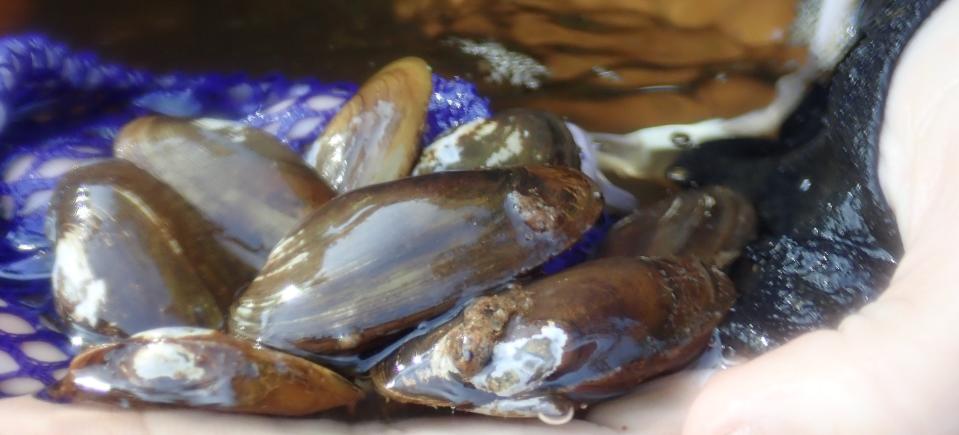Salamander mussel, sentinel of river health, could be listed as endangered
The U.S. Fish and Wildlife Service has proposed adding the salamander mussel, considered a silent sentinel of the health of rivers and streams in Michigan and elsewhere around the country, to the federal list of endangered species.
According to the Fish and Wildlife Service, water quality tends to be good where these mussels thrive, and when their population is in decline, the rivers and streams they inhabit may be unhealthy. These mussels are not to be confused with the zebra mussels, an invasive mollusk native to Eurasia that attach to incapacitate native mussels and clog water intakes at power plants.
In addition to being indicators of river health, freshwater mussels can keep water clean by filtering their food from the water, and with it, sediment and other pollutants. According to the wildlife service, there are are more than 900 species worldwide, with North America being a global center of mussel diversity, with about 300 species. Despite the high amount of diversity, 65% of North American freshwater mussel species are imperiled..
The Wildlife Service proposed listing these little salamander mussels as endangered under the Endangered Species Act in August and is seeking public comment on it recommendation. This freshwater mussel is found in scattered populations across 14 states, from New York southwest to Arkansas. The service is also proposing to designate critical habitat for the salamander mussel.
"We at the U.S. Fish and Wildlife Service have proposed to list the salamander mussel as endangered under the Endangered Species Act. Endangered species protections would benefit this species, if listed, by raising awareness about the threats to it, inspiring conservation partnerships and making resources available for recovery," said agency spokeswoman Melissa Clark.
What they look like

According to the Michigan State University Extension Service, the salamander mussel has a small, up to 2 inches, thin, elliptical shell. The outside of the shell is smooth and a dull yellow tan to dark brown. Its habitat is in swift flowing rivers and streams with areas of shelter, under flat rocks or in crevices.
While rare, the salamander mussel can be found in abundant patches linked to its host, the mudpuppy. Mudpuppies are salamanders that live in lakes, rivers and ponds and get their names from the grunting sounds they can make, according to a mudpuppy fact sheet from the wildlife division of the Connecticut Department of Energy and Environmental Protection.
More: Michigan seniors reveal their secrets to a long and happy life
More: Police preparing to rescue Detroit woman on a high-rise ledge
The Fish and Wildlife Service is taking public comments on the salamander mussel designation until Oct. 23.
In addition to Michigan, the mussel is found in Arkansas, Illinois, Indiana, Iowa, Kentucky, Minnesota, Missouri, New York, Ohio, Pennsylvania, Tennessee, West Virginia, Wisconsin and Ontario, Canada.
The primary threats facing the mussel include contaminants, changes in water flow and the landscape, invasive species and risks to the mudpuppy. According to the service, fresh water mussels are among the most sensitive of aquatic species, so changes in water quality can have a range of negative impacts.
The wildlife service is also proposing to designate critical habitat for the salamander mussel. Critical habitat is an area that contains essential habitat features for the survival and recovery of a listed species.
Saving critters for 50 years
This is the 50th anniversary of the year when Congress passed the Endangered Species Act, which has helped save the bald eagle and other wildlife. It is designed to protect threatened species from harm, including interference with their vital breeding and behavioral activities, or degradation of their critical habitat, according to the National Wildlife Federation. .
According to the wildlife service, similar to other fresh water mussels, the salamander mussel has a unique life cycle that relies on its host for successful reproduction, but the salamander mussel is the only freshwater mussel in North America to use a nonfish host. The mudpuppy, the only host for salamander mussel, is a fully aquatic salamander species that is present within the same habitat preferred by the salamander mussel during the summer and fall when female mudpuppies are guarding their nests under large flat rocks. The salamander mussel’s larvae develop on the gills of the mudpuppy before falling off into the stream.
Like other freshwater mussels, the salamander mussel feeds on particles, including phytoplankton, zooplankton, rotifers, protozoans, detritus, and dissolved organic matter, in sediments or suspended in the water. The salamander mussel lives for approximately 10 years.
How to comment
The proposal to put the salamander mussel on the list of endangered species and other documents are available for comment online at https://www.regulations.gov under docket number FWS-R3-ES-2023-0058. Hard copy comments may be mailed to Public Comments Processing, Attn: FWS-R3-ES-2023-0058, U.S. Fish and Wildlife Service, MS: PRB/3W, 5275 Leesburg Pike, Falls Church, VA 22041–3803.
The service requests that comments be sent only by the methods described above. It said it will post all comments on https://www.regulations.gov.
Learn more about the salamander mussel.
This article originally appeared on Detroit Free Press: Salamander mussel may be declared as endangered

